What is SEO: A Complete Guide to Search Engine Optimization
SEO or Search engine optimization is a common topic among businesses these days.
Take, for example, before you came across this post you’re reading right now, you entered a search query.
You had to type in what you were interested in (a keyword) and hit enter while Google or Bing did their thing. These search engines gave you some search results based on your search query, and now you’re here.
So the question is, how do pages, websites or businesses make it to the top search results?
The answer is simple: good search engine optimization.
As an entrepreneur, a brand or a business owner, SEO is one of the safest and unpaid ways to get three things done:
- Increase your website visibility
- Boost your brand awareness
- And get across to potential customers, thereby increasing conversion
I’ll walk you through the A-Z of SEO in the next few minutes. When you’re done reading this detailed post, you’ll know exactly how it works and how to do SEO yourself.
What is SEO?
This is the first obvious question you need clarity on. SEO stands for “search engine optimization.”
SEO refers to the strategies you have to use for search engines to rank your web pages or content higher in search results.
The higher your content or web pages appear for specific search queries, the more traffic you get.
And, of course, you know what good traffic can do for your business.
It increases your site visitors, which means more brand awareness. Some of these visitors who visit your site tend to be more interested in your products or services.
Basically, SEO improves your ranking in SERPS. Anytime people search for keywords relevant to your business, you’ll pop up in search.
For example, as a coffee shop or brand, you could rank for a search term “best coffee in the UK”. All you have to do is write quality content on that search term that would rank on the top page of SERPs.
Did you know that Google receives more than 63,000 searches per second yearly? That’s a huge number right there. As a business owner or entrepreneur, SEO helps you tap into this number to grow your business.
So, that answers the question, what is SEO. With that on the side, let’s talk about how SEO works.
How Does SEO Work?
It’s not complex to understand how search engine optimization works. SEO works by improving your site’s ability for three important things:
- Crawling
- Indexing
- Ranking on search engines
Let me explain this.
Still remember the coffee example I gave earlier? Now, let’s say you wanted to target the keyword “the best coffee in the UK” for people searching for it on Google.
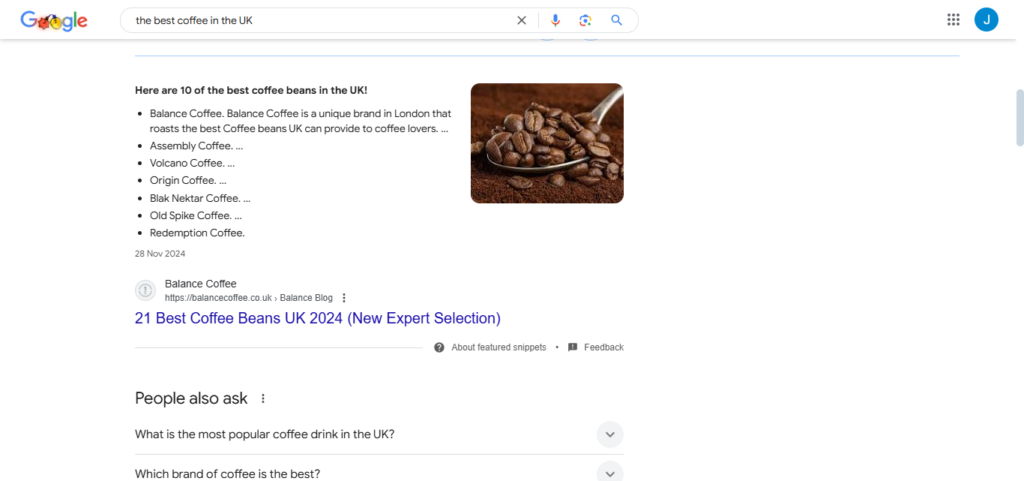
From the screenshot, you can see that Google gave some results based on the keywords we entered.
The first business that ranked number one in this search was Balance Coffee. What’s the message here? The coffee brand had to do quality SEO for that search query.
This means writing quality, relevant content targeting that keyword. This includes titles, keyword research, tags, headings, links, quality images and more.
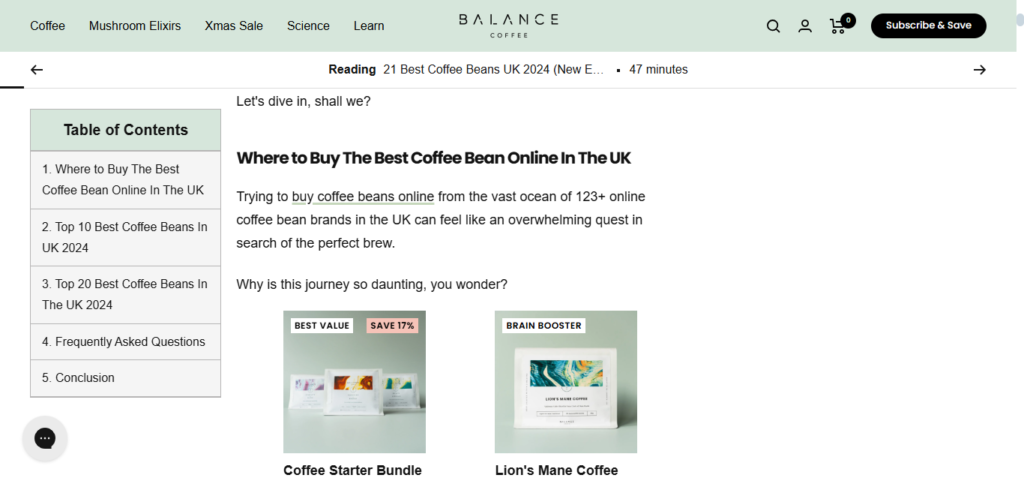
Looking at the content they wrote on this, as seen in the screenshot above, you can see they’ve used optimized headings, some internal and external links, and quality images. They also carried out keyword research for that search query.
So, search engines crawl this website, scanning the content and metadata when the content is published.
The page or content will get indexed if relevant to search queries. Their blog content is indexed in this example because it is very relevant.
Indexing means when your web pages or content are eligible to start ranking.
Now, you’re probably wondering how search engines rank indexed pages. Well, there are a lot of factors that contribute to this. However, authority, trust, quality, and content optimization are obvious factors.
Higher-ranked pages like the example we used here will organically appear on the first page of search engines.
If you know how SEO works and can execute it for your business, you can improve your traffic and generate more leads and sales.
It’s one of the most cost-effective strategies for long-term growth.
Note: We offer an SEO content writing service where our in-house team takes care of your content SEO if you prefer to spend your time on other aspects of your business.
Benefits of SEO
As a business owner or entrepreneur, good SEO has several benefits. However, I will focus on the five main benefits of SEO for your brand or business.
1. Increased website traffic
When your business or website ranks higher for specific search queries, you get more organic traffic, which can exponentially drive your sales growth.
For example, when someone searches on Google for the “best headlamps in the UK”, there are most likely two search intents here for that query he or she just made.

It’s either an information intent or a purchase intent. This means that a person is either looking for good information about headlamps in the UK or wants to buy a headlamp immediately.
So, if you write blog content targeting that specific search term, it’s well SEO Optimized and eventually ranks in the top 1 to 5 spot of Google, you’ll get a lot of traffic from there. And, of course, you can get some sales from folks who want to buy immediately.
2. Higher conversion rate
This is a bit similar to the first benefit above. As I said earlier, when your website ranks on the first page of Google, you attract more organic traffic.
If it’s a purchase intent like the example of” the best headlamp in the UK” we mentioned earlier, you’ll get a higher conversation rate from all the traffic coming your way.
At some point, the business will get a lot of sales from customers who want to purchase a headlamp.
3. Lower cost per acquisition
SEO is the most cost-efficient way to grow your business. As a business or brand, there are two ways you can get across to potential customers online. It’s paid advertising and SEO.
Attracting website visitors through SEO will cost you pennies compared to what you’ll have to spend on paid ads now and then.
An SEO-optimized blog content or web copy can stay on the top page of SERPs for several years as long as you keep updating and improving the content to stay ahead of competitors.
Unfortunately, we can’t say the same for paid advertising. Your ads stop showing immediately after you end your campaign.
To get across to potential customers with this method, you will have to run paid ads tirelessly occasionally. Plus, the conversion could be low and disappointing.
4. Brand visibility
Brand visibility is important, especially for new businesses that have yet to put their foot on the ground.
When you rank ahead of competitors in your industry on the first page, it sends a good signal that establishes your authority. Over time, if your team keeps up the brilliant job, people will trust your brand.
5. Competitive advantage
One of the many benefits of SEO is the competitive advantage it offers. You’ll always know your competitors and try to stay ahead of the curve.
Outranking your competitors means there is a huge potential for capturing more market share over time.
Types of SEO
When it comes to optimizing your business or website for search engines, there are a few key types of SEO you have to place more focus on:
1. On-page optimization
On-page optimization is about optimizing your web pages with relevant keywords people are searching for around your industry or niche.
You’ll have to handle some things, like page titles, meta descriptions, headlines, image alt text, body content, URLs, and more.
On-page SEO helps search engine crawlers understand what your business is about or the topic you’re trying to rank for.
2. Off-page optimization
This is also known as link building. Here, you have to acquire good and indexable backlinks from external websites to improve your site’s relevance and domain authority. Great backlinks from websites or sources that Google already trusts can be very beneficial.
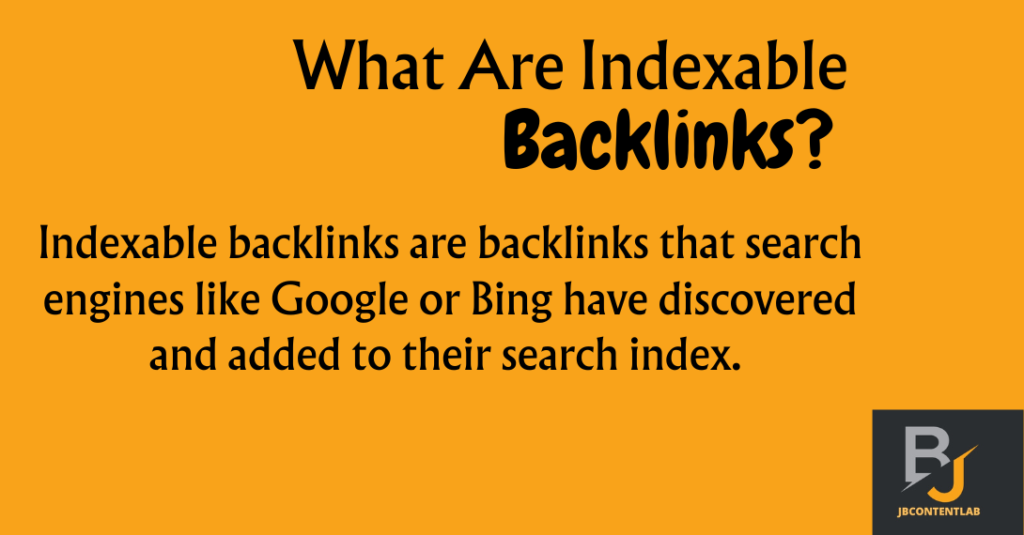
3. Technical SEO
Technical SEO is the kind of SEO that happens behind the scenes of a website. It has a great impact on factors like crawling, indexing and ranking.
For technical SEO, you’ll have to hire an expert to take care of quite a few things. This includes your site speed, mobile responsiveness, structured data markup schema, image compression, proper URL paths, etc.
4. Local SEO
If your business is in a physical location, Local SEO is something you want to pay attention to.
It can help a great deal to improve your business visibility for nearby searches.
Let’s say I’m new to a neighbourhood and ran out of scented candles, so I need some replacements. In this case, I’m a potential customer looking to purchase a product.
I will most likely search on Google “where to buy scented candles near me.” When I search for that search query, Google will show me some local businesses that sell scented candles near my location.
You can see that from the screenshot below.
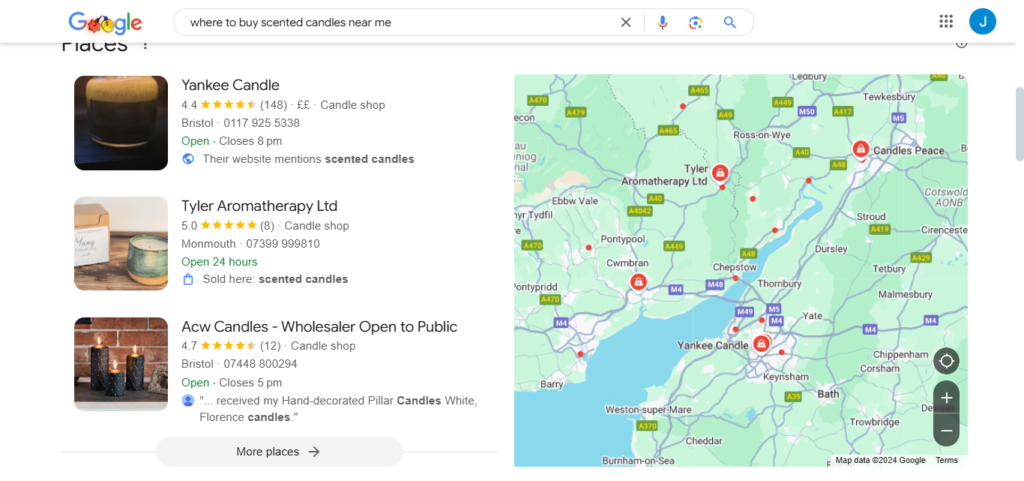
As a customer, I’d most likely take a short walk to Yankee Candle, Tyler Aromatherapy or Acw Candles to make my purchase. Or I could place an order with any of them through their website and get my candles delivered to me.
That’s the result you can get with local SEO as a small business, brand or entrepreneur.
5. Image SEO
Image SEO is trying to use alt text descriptions to help search crawlers understand the content within your image so it can rank better compared to other images.
A lot of websites pay very little or no attention to Image SEO. However, you’ll never tell when small details like this can be helpful for SEO strategy.
6. Video SEO
Video SEO includes optimizing your video file names, titles, descriptions and transcripts to help search engines understand the content within videos so they can rank it.
Search Engine Marketing vs. Search Engine Optimization
Many confuse search engine optimization (SEO) with search engine marketing (SEM). But the truth is, they are very different concepts:
SEO involves unpaid, organic strategies for getting your web pages to rank higher in search engines. In other words, it uses optimization best practices to improve your ranking over time.
SEM is paid advertising. You have to use methods such as Google Ads, where you bid on keywords to have your ads appear at the top and side of search engine results. You pay each time someone clicks your ad.
So, what does this mean for you as a business? It’s simple: you have to pay more attention to SEO if you don’t want to sacrifice so much on paid advertising almost every week.
Once you get your SEO on track, you can now leverage the opportunities from SEM every now and then. That’s our recommended way to go about these two strategies for your business or website.
SEO Ranking Factors
So, how exactly do search engines like Google decide where to rank web pages?
While Google keeps its exact ranking algorithm a closely guarded secret, they have disclosed that over 200 ranking signals or factors are involved.
When optimizing your website, blog, or local listings, some of the most influential SEO ranking factors to pay keen attention to include:
- Page speed and performance
- Mobile-friendliness
- Domain name, age and authority
- Quality backlink profile
- On-page optimization
- Engaging and useful content
- Low bounce rates and high dwell time
- Positive word-of-mouth and reviews
- Structured data markup
- Local listings accuracy and consistency
Improving each of these signals can directly impact how well your website ranks and organic visibility over time. So, it’s really important you get your on-page and off-page optimization right on track.
How to Do SEO: On-Page Optimization
When it comes to ranking individual web pages, on-page SEO optimization is crucial. Below, I’ll explain how to do on-page SEO for your website or business.
Step 1: Know your audience’s search Intent
Knowing your audience search intent means you must know what your potential customers or clients search for on Google.
People search for things on Google using keywords. They will use long-tail or short-tail keywords to search for things around your product or services.
All you have to do is curate great content or execute local SEO targeting these keywords to make these audiences (your potential customers) visit your site.
For example, when I enter a short-tail keyword like “coffee in the UK” on Google, Google gives me some results, as seen in the screenshot below. What you’re seeing is the first business Google is ranking for that search query at the moment.
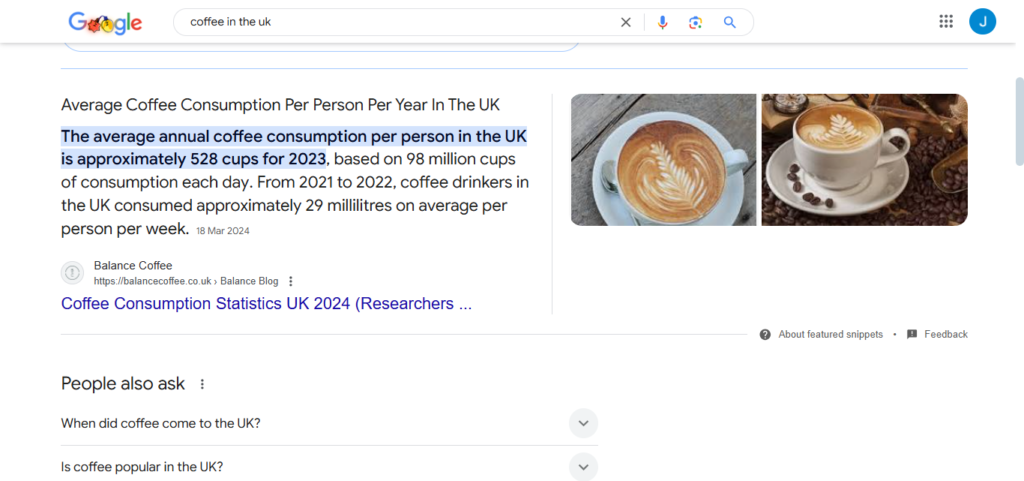
But when I enter a long tail keyword like “Where can I buy the best coffee beans in the UK.”
Google gave a different result.
It showed me some local businesses that were ranking for that search term. This is because those businesses have carried out local SEO targeting that search query I made.
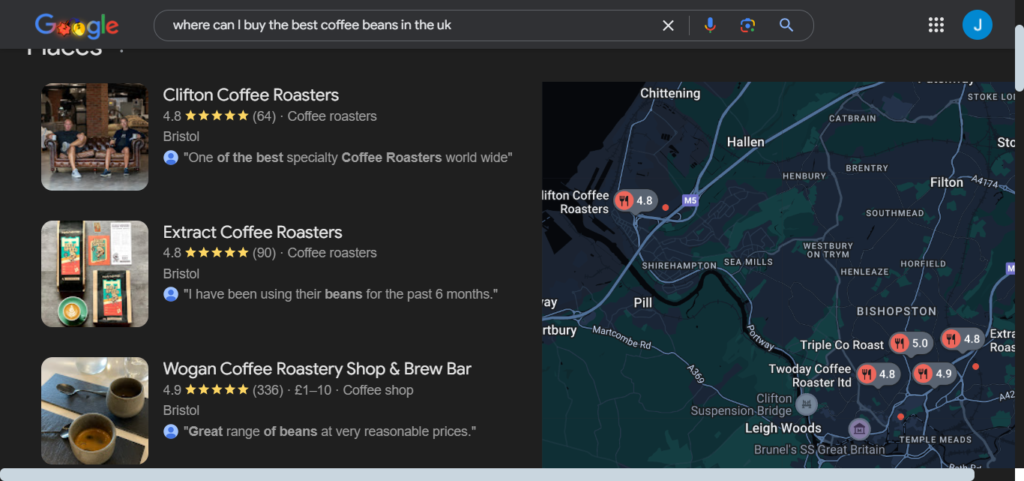
Then Google showed me some businesses that have written great SEO blog posts targeting that same search query.
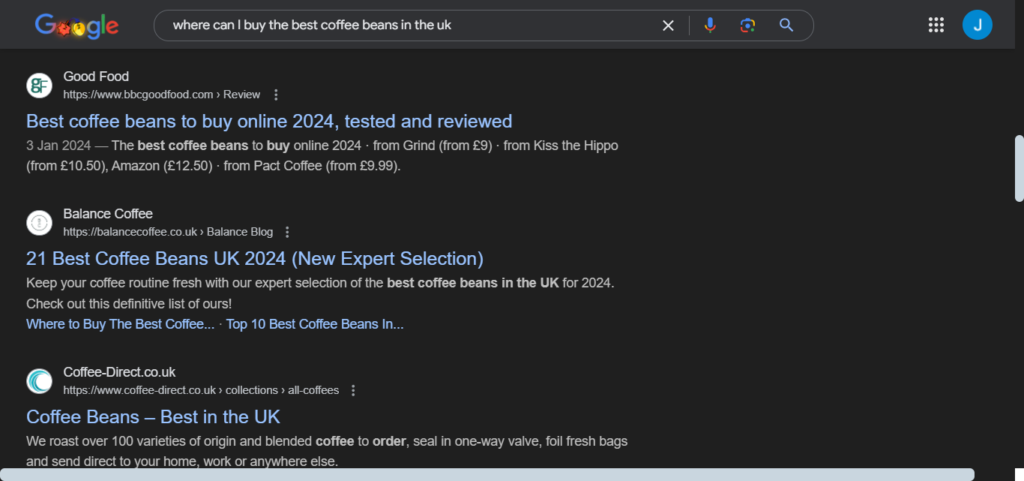
This time, Good Food sat on the top spot, followed by the brand, which ranked first in the first search query. This is a clear example of understanding your audience’s search intent.
All you have to do as a business is write quality SEO content or execute local SEO targeting certain keywords around your industry to make this audience (your potential customers) visit your site.
The goal is to tap into demand that already exists.
Step 2: Conduct keyword research
Once you know the main topics people are searching for around your industry, use Google Ads Keyword Planner or other tools like Ahrefs to find keyword variations, search volumes, and competitiveness data.
This helps you identify opportunity areas. Prioritize keywords aligned to your business offerings and audience needs.
Step 3: Create quality content using those keywords naturally
With your list of priority keywords, create targeted content around those topics that align with searcher intent.
Whether writing a blog post or optimizing a product page, use keywords naturally throughout the content – not just for search engines but for readers, too. It’s really important you provide truly useful information.
Step 4: Optimize your titles with the primary and secondary keywords
The title tag and headline are critical for signalling to search engines the focus of the content on the page. Include your primary and secondary keywords in compelling titles that make searchers want to click.
Step 5: Optimize your meta descriptions
Meta descriptions summarize page content in 160 characters or less. This snippet is shown under the title tag in search listings. Ensure you incorporate keywords here as well.
Step 6: Add quality images and optimize them
Include relevant, high-quality images in your content, and name the files and alt text with target keywords, too. Images help break up blocks of text and engage readers.
Step 7: Include some internal and external links
Links help search bots crawl new pages and reinforce page relevance. Link out to credible external resources for readers. Internally, the link-related content is on your site. This builds trust and authority with both users and search algorithms.
How to Do SEO: Off-Page Optimization
In addition to individual page optimization, SEO success requires a long-term link-building strategy to increase your domain authority and relevance. Here is how to do off-page SEO.
Link building
Reaching out to related sites and resources within your industry to request backlinks remains one of the most tried and true off-page SEO tactics. Link building helps build relationships with sites that align with your brand and content focus. Provide value to earn links back to your content.
Content marketing
Consistently publishing engaging, useful content attracts organic traffic and earns links back from readers sharing that content. Podcasts, videos, blog posts, and tools that solve problems can all go viral, building huge momentum.
Digital PR
Pitching trending stories or data to journalists and publications related to your industry is a great way to earn high-authority backlinks. Reporters are always looking for experts to quote and contribute opinions on relevant topics.
Social media
An active social media presence means readers can naturally find and share your content with their networks. Make it easy to share. Links from sites like Facebook, LinkedIn and Twitter pass authority.
Influencer marketing
Partnering with relevant bloggers, industry experts, and thought leaders provides credibility by association. They can help amplify your content and build buzz through shares.
Guest posting
Proactively writing and contributing posts for niche websites and blogs helps expand your brand’s reach. Always provide value for readers first. A link back to your site is a nice added bonus.
Podcasts
Hosting your own podcast or securing guest interviews on other popular shows exposes your brand and expertise to new audiences. Podcasts often link back to your website in show notes, too.
As you expand your off-page footprint over time, remain patient and persistent. High-quality links compound, building the authority that can propel your site up in the rankings.
Google business profile
Claim and completely optimize your free Google Business Profile, formerly known as Google My Business. This serves as your digital storefront on Google, showing customers your address, hours, photos and more.
Name, address and phone number consistency
Keep your business name, address and phone number completely consistent across 50+ online directories and citation websites. This establishes local relevance signals.
Reviews
Activate and monitor customer reviews across Google, Facebook, and industry sites. Positive local sentiment builds trust and social proof. Encourage authentic reviews from real customers.
How Our In-House Team Can Help With SEO
With everything we’ve shared so far, it’s very clear that an effective SEO strategy takes a lot of time, effort and technical effort.
But being a very busy business owner or entrepreneur, you most likely don’t have time to do your business’s SEO work. Yes, coupled with the fact that you have to manage other aspects of your business.
So, while DIY SEO is certainly possible, I strongly recommend you let experts handle this.
And that’s where our in-house team at JBcontentlab can help.
If you love everything you’ve read and seen so far and want a team that can handle your website SEO content to utterly outrank your competitors, we’ll be delighted to help your business.
We can be your in-house team for SEO content writing, website copywriting, link building and local SEO. Let’s help you get SEO done the right way while you focus on other core aspects of your business.






